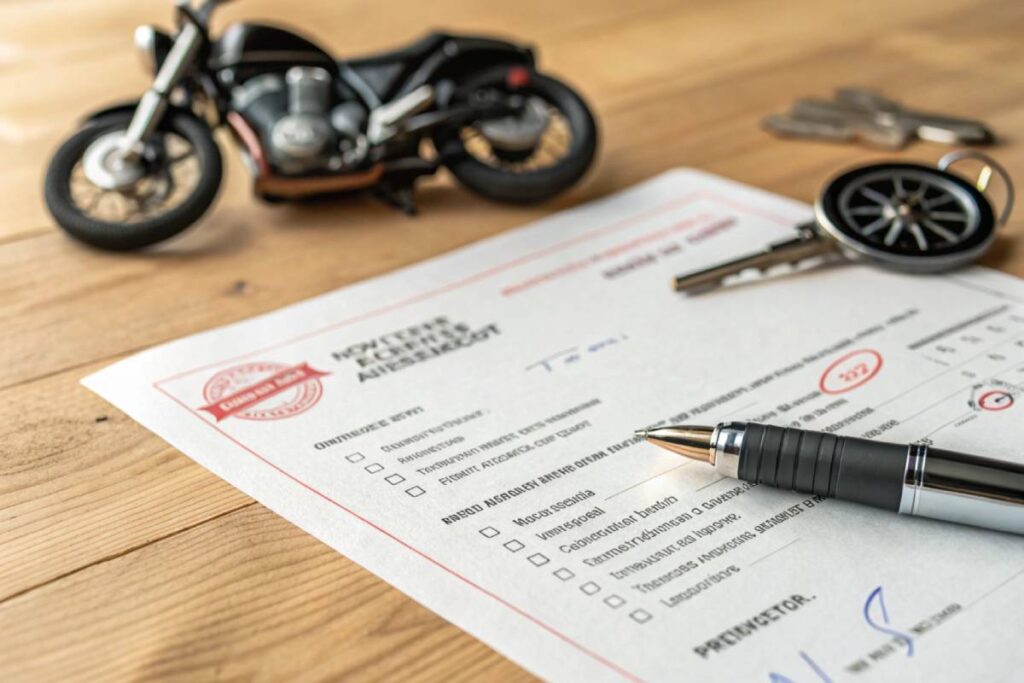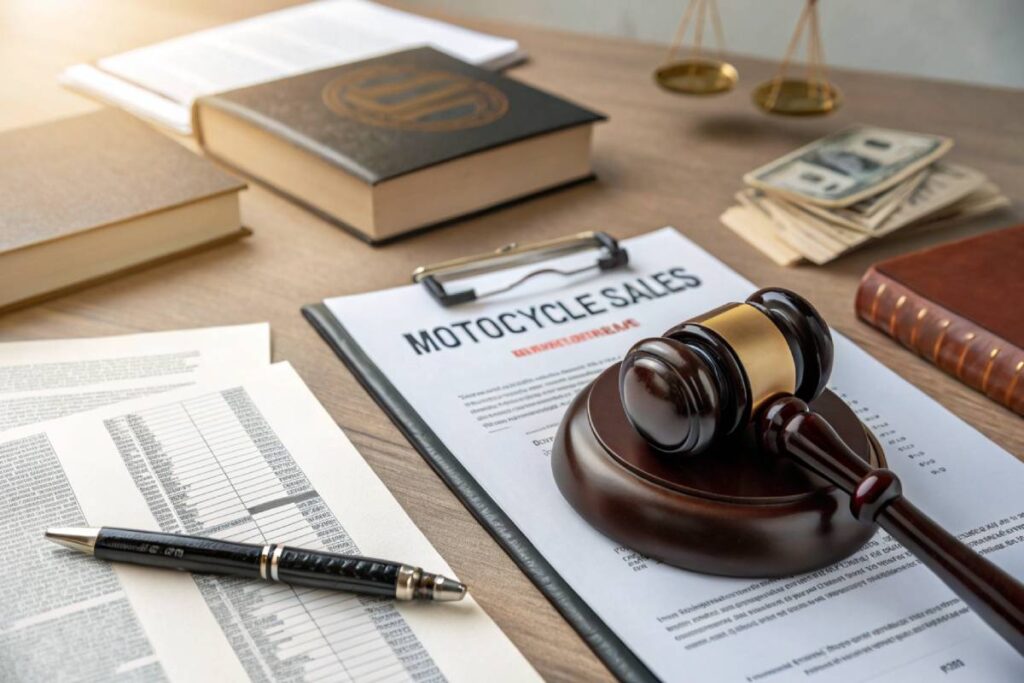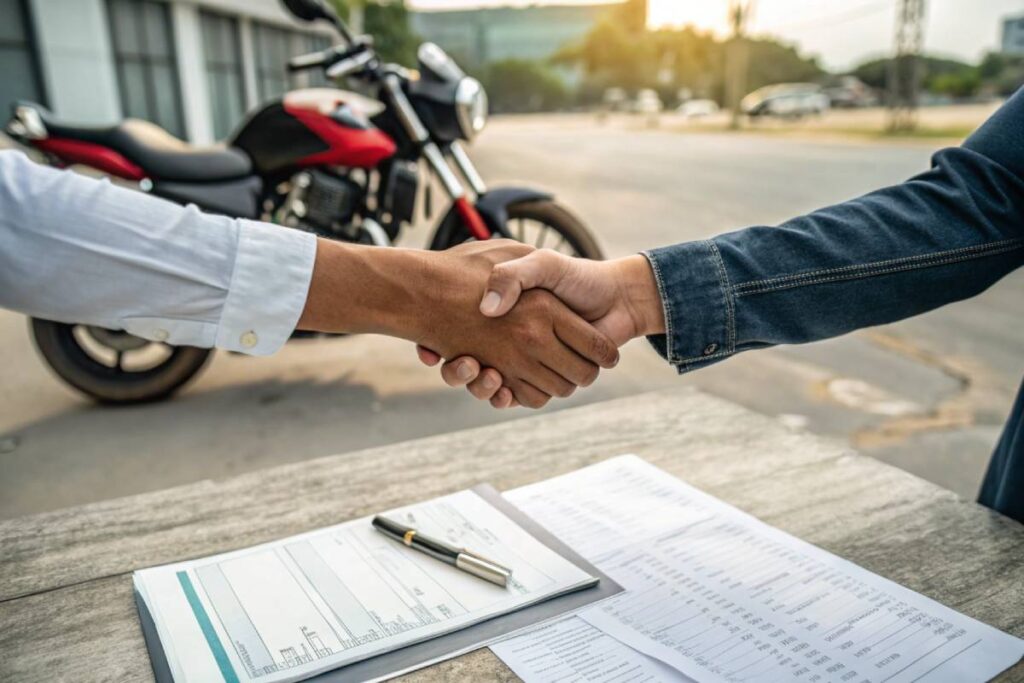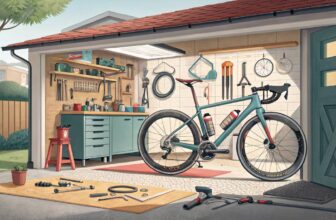Purchasing a bike is more than just a thrilling ride—it’s a commitment that involves crucial paperwork to ensure a smooth transaction. Imagine sealing the deal with confidence, knowing every detail is covered and protected.
In this article we delve into the essentials of crafting a foolproof purchase agreement, safeguarding both buyers and sellers.
Whether you’re a seasoned rider or a first-time buyer, mastering these agreements ensures your new wheels are yours to enjoy without any unexpected bumps along the way.
Understanding the Purchase Agreement
Buying a bike isn’t just about picking the shiniest set of wheels—it’s got some paperwork too! One of the biggies is the purchase agreement, which is like a handshake on paper between the buyer and seller, spelling out all the must-knows of the deal.

Importance of a Purchase Agreement
Think of a bike purchase agreement as your pact with the seller. This document isn’t just for show; it spells out:
- Clarity is king: It lays out exactly what you’re putting your John Hancock on and what the seller is promising.
- Shield in a storm: If things go a bit sideways, this paper can be your lifeline.
- Receipt on steroids: Not just proof you bought the bike, but also handy for things like registration down the line.
Plus, if numbers make your head spin, check our bike price guide for a peek at retail numbers and how they might nudge your agreement.
Elements of a Purchase Agreement
A rock-solid bike purchase agreement covers all bases, ensuring you know what you’re signing up for.
Purchaser and Seller Information
Both sides of the deal should have their details in the loop:
- Names, so you know who’s who.
- Where you both hang your hats.
- Digits for a chat if needed.
Vehicle Specifications
Bikes aren’t just bikes; here’s what you’ll need to note:
- Year it rolled out.
- The badge and brand.
- The VIN, which is basically the bike’s secret handshake.
| Element | Description |
|---|---|
| Year | The year your bike left the factory. |
| Make and Model | The brand name and the exact model type. |
| Vehicle Identification Number (VIN) | A special code that tells your bike from its twins. |
Sales Price and Payment Terms
Cash talk time! Here’s what’ll be on the docket:
- The cash tag or the price you’ll actually pay.
- How you’ll pay it—lumps, bits, or swaps.
The first piece of the contract pie? Check out the cash price or selling price of your newbie ride.
Condition of the Vehicle
You’ll want to know your bike’s style and swagger:
- How many spins are on the odometer?
- Boo-boos and scratches to watch out for.
- Fresh fixes or TLC recently done.
Important Legal Statements
Extra credit includes stuff like what you’re trading in and more on warranty disclaimers.
Curious about nailing the bike sales contract? Roll over to our page on bike ownership transfer.
Planning to shop around? Scope our where to buy bikes guide for top spots to snag your wheels and the bike inspection checklist to be sure your future ride is the real deal before the big signature.
“A solid purchase agreement is the foundation of a trustworthy bike transaction. It ensures that both parties are clear on the terms, reducing the risk of misunderstandings.”
— Jane Doe, Professional Motorcycle Sales Consultant
Legal Aspects of a Purchase
Buying a bike is more than picking your favorite color and riding off into the sunset. It’s important to understand the legal aspects involved to prevent the deal from going wrong. Knowing what the buyer and seller need to do can make the deal as smooth as a fresh set of tires.

Seller’s Responsibilities
You can’t just hand over the keys and call it a day. Sellers have to do their part to keep everything above board:
- Disclosing Faults: Sellers have to spill the beans on any issues with the bike. We’re talking mechanical quirks, fender benders, and anything else that might mess with performance or safety. Nobody likes surprises, especially when they’re revving up for the first ride.
- Accurate Documentation: You gotta have your papers in order. This means:
- Proof of ownership (yes, the title)
- A rundown of past services
- Any other documents that ensure the buyer knows what they’re riding into
3. Matching the Description: The bike should be exactly what was promised. If the contract says the bike has a new exhaust or fancy foot pegs, that’s what should be sitting in the driveway.
4. Cleaning and Presentation: Let’s not forget looks matter. A clean bike, with snappy photos, and a pinch of market research can really bump up those offers. First impressions count when you’re selling speed on two wheels.
Buyer’s Obligations
It’s not all on the seller. Buyers have a checklist of their own to make sure they’re not getting a lemon:
- Inspection and Test Ride: You wouldn’t buy shoes without trying them on first, right? Take that bike for a serious test spin. Bring along a buddy who knows their stuff and clock up to 100 kilometers to see if it’s comfy and handles like a dream.
- Insurance Verification: Check that insurance box before sealing the deal. It shields you from any hiccups down the road that could hit your wallet hard.
- Final Payment: Pay up as promised. Make sure the deal’s ink is dry on the purchase agreement before handing over the cash.
- Payment Confirmation: Double-check the seller got the dough. This step is as crucial as a full tank before a long journey.
- Credentials for Test Drives: Don’t forget your driver’s license and helmet. You wanna stay safe and legal out there.
- Signatures and Documentation: Finally, get everything signed. The bill of sale and odometer reading lock it all in. Without signatures, it’s just pen on paper.
When both sides know what they’re doing, it’s a win-win. If you’re still unsure, peek at tips on used bike inspection and avoid bike buying mistakes. Happy riding!
Crafting a Motorcycle Bill of Sale
Getting a motorcycle sold or buying a dream ride? You need more than a handshake. That piece of paper we call a bill of sale is a lifesaver. It keeps the buyer and seller safe as houses. This doc is like the golden ticket to registering your new wheels. Check out the bits and bobs it needs, and why you should think about getting it notarized.
Details to Include
Making sure your bill of sale has all the right stuff is like making a sandwich—you can’t miss the key ingredients. Here’s what to slap on there to keep everyone happy and avoid any hiccups later.
1. Who’s Involved
- Full Names
- Where they Live (Addresses)
- How to Get in Touch (Contact Info)
2. About the Bike
- Brand and Model
- Vehicle Identification Number (VIN)—think of it as the bike’s SSN
- Make Year
- Mileage on the Odometer (when selling)
3. Transaction Lowdown
- Date when the Deal’s Sealed
- Price Tag
- Payment Method (are we talking cash, check, or bank stuff?)
4. Put Your John Hancock
- Buyer’s Signature
- Seller’s Signature
Optional sprinkle:
- Notary Signature (depends on state rules)
| Detail | Why It Matters |
|---|---|
| Buyer & Seller Details | Clearly identifies who’s who. |
| Bike Specs | Essential info on what’s being sold. |
| Sale Details | Outlines cost and how it’s paid. |
| Signatures | Seals the deal officially. |
Want more on bike documentation? Peep our guides on bike check-up and getting it registered.
Importance of Notarization
Notarization might sound fancy, but it’s just a way to make things official with a stamp and all. Here’s why you might want to do it.
- Cover Your Back
A notary means everyone’s on the same page—literally. It’s a safety net against any “he said, she said” later on. Our pals at LegalZoom say it helps sidestep legal headaches, too. - Prove It’s Yours (or Theirs)
A notarized sale sheet is like the birth certificate for your shiny new bike-to-owner relationship. - Follow the Rules
Some places (cough certain states) will slap your wrist if it ain’t notarized. Check with your local DMV so you don’t hit a snag. - Mileage Check
With notarized mileage, you don’t just take their word. It locks in what the odometer says, which can be crucial for some legal stuff.
| Benefit | What It Does |
|---|---|
| Legal Cover | Keeps disputes at bay with a witnessed agreement. |
| Ownership Proof | Officially records the change of hands. |
| State Rule Compliance | Keeps you on the right side of state laws. |
| Mileage Verification | Confirms the miles shown are legit. |
A motorcycle bill of sale? It’s your transaction’s wingman. For more on catching the best deal, slide over to our price tracking tips and how to haggle.
Dotting all i’s and crossing t’s with your motorcycle bill of sale not only brings peace of mind but also smoothes out the ride for you and the other person involved.
Key Stuff in a Bill of Sale
Crafting a solid bill of sale is like having your grandma’s homemade pie—it just feels right and saves a world of trouble. This little gem locks down your bike-buying journey, protecting you and the other person, making sure everyone’s looking on the same page. Here’s the scoop on what needs to be in that bill of sale to keep things smooth as a Sunday ride.
Buyer and Seller Basics
Your bill of sale’s got to spell out who’s buying and who’s selling. Here’s what’s needed:
- Full names of both parties
- Home addresses
- Handy contact info like phone numbers or emails
Putting this stuff in writing keeps everyone honest and ready in case of any bumpy roads ahead.
| Information Type | Buyer | Seller |
|---|---|---|
| Name | [Full Name] | [Full Name] |
| Address | [Street Address] | [Street Address] |
| Contact Info | [Phone/Email] | [Phone/Email] |
Nailing down these details keeps the deal legit. Wanna know more about the nitty-gritty of bike buying? Hit up our bike price guide.
Bike Bits and Bobs
- Make and Model: Get the specifics of the bike’s brand and style down.
- Year of Manufacture: When was this beauty made? The year helps figure out the bike’s worth.
- Vehicle Identification Number (VIN): This one’s like the bike’s fingerprint. Writing down the VIN leaves no room for mix-ups.
- Odometer Reading: How far has this bike gone? Jot down the mileage at sale time for a peek into its past rides.
| Vehicle Specs | Crib Notes |
|---|---|
| Make and Model | [Make, Model] |
| Year of Birth | [Year] |
| VIN Digits | [VIN] |
| Odometer Reading | [Mileage] |
Need more info on what makes your wheels go around? Check out our compare bike specs.
Important Extras
- Date of Sale: Pin down the exact day everyone shook hands.
- Price Tag: What’s the agreed damage to the wallet?
- Payment Style: Was it cash in hand, a slip of paper, or a digital nod?
- Signatures Signed: Both sides need to scribble their names to seal the deal. Some places might need an official stamp—know your local rules before you chill.
| Deal Details | Cheat Sheet |
|---|---|
| Day of Exchange | [Date] |
| Agreed Amount | [Amount] |
| Payment Done Like | [Cash/Check/Bank Transfer] |
| Signatures Needed | [Buyer & Seller] |
Spelling out these bits keeps things clear and aboveboard, especially if questions pop up later on. If you’re swapping up, don’t miss our guides on new vs used bikes and used bike inspection.
Knowing what a bill needs can steer you clear of any shady stuff. Want more savvy tips on bike shopping and dodging legal headaches? Peek at our guides like how to test ride bikes and negotiate bike prices.
Executing a Motorcycle Sales Contract
Buying or selling a motorcycle? Better get that sales contract right! A solid contract seals the deal, making it smooth and legally tight. Here’s how you handle the nitty-gritty without losing your cool.
Negotiating Terms
When you’re hashing out a motorcycle deal, getting the terms just right is the name of the game. It’s like making sure everyone leaves the table happy—or as happy as they can be when cash is involved!
Here’s what ya need to cover:
- Price: Lay it out upfront—the cost of that beast on wheels. Toss in any taxes or extra fees while you’re at it.
- Delivery Details: Who’s dropping off the ride and when? Spell it out, so nobody’s left waiting.
- Warranties: Is there a safety net if things go south? Cover the fine print on what’s guaranteed.
- Payment Terms: Cash, check, or gold bars? Whatever floats your boat—just make it clear.
- Inspection and Condition: Make sure everyone agrees on what’s being sold. Maybe snap a few pics, so arguments don’t pop up later over a scratch that wasn’t there before.
Clients don’t want their wallets hurt! Check more tips on our negotiate bike price page.
Keeping It Legal
Now, you gotta make sure your deal doesn’t just sound good—it has to hold up in court if things go sideways. Here’s the cheat sheet:
- Ownership Transfer: No surprises here. Make it crystal clear who owns what once the money’s dealt.
- Fixing Bust-Ups: Be smart—have ways to iron out any trouble, like chats or sit-downs that keep the lawyers out of it.
- Buyer Rights: No funny business—respect what’s fair for the buyer while keeping things square.
- Legal Stuff: Don’t break any rules, whether they’re written down in the big city or your friendly neighborhood.
If paperwork isn’t your jam, grab some pre-made templates from places like Lawrina. They’ve got your back to keep everything legit.
Dive into more advice with our bike warranty guide and bike registration guide.
By nailing down these terms and keeping everything legally sound, buyers and sellers can chill and stay clear of any nasty surprises. For more tips, cruise through our bike insurance guide and bike ownership transfer.
Protecting Both Parties
When buying or selling a bike, keeping everyone happy and honest is the goal. A little elbow grease here can save you a lot of hassle later.
Dodging Disputes
Setting everything straight from the start with a bike purchase agreement can save headaches later. When both sides know what’s what, it keeps misunderstandings at bay.
- Lay it Out: Make sure your agreement spells out details like bike make, model, VIN, price, payment method, and any promises made.
- Check Under the Hood: Agree on the bike’s condition. Sellers can hand over a thorough inspection report, and buyers should snap some pics or record a walk-around to save anything fishy. Need help? Have a look at the used bike inspection.
- Mileage Check: Slap in an odometer disclosure to show how far the bike’s been. It’s required, and it’s a good peace of mind.
Nipping Fraud in the Bud
Making sure the deal is legit can block shady stuff from happening. Here’s some tips every buyer and seller should stick to:
- Who’s Who: Double-check IDs on both sides like it’s the airport. It’s not nosy – it’s smart.
- Money Matters: Steer clear of cash or sketchy wire transfers. Trackable payment routes like escrow services or certified checks are your best pals. Want more info? Browse our advice on how to pay for bike.
- History Lesson: Grab a report on the bike’s history – prior owners, crashes, fixes. It helps you match up the seller’s story.
- Make It Official: Even if it’s not required, getting the bill of sale notarized never hurts. It’s just another way to keep the transaction legit and safe.
| Key Action | Purpose |
|---|---|
| Lay it Out | Clear up transaction details |
| Check Under the Hood | Confirm bike’s shape |
| Mileage Check | Verify miles traveled |
| Who’s Who | Validate participants |
| Money Matters | Secure payment solutions |
| History Lesson | Back up seller claims |
| Make It Official | Boost document’s authority |
Want to crank up your skills in writing a bill of sale? Catch our section on crafting a motorcycle bill of sale. Avoid the slip-ups at bike buying mistakes.
Following these steps keeps everyone honest and the deal smooth, protecting both buyer and seller when that motorcycle changes hands.
“Clear documentation and transparent agreements are essential for maintaining trust and preventing disputes in bike sales.”
— John Smith, Veteran Motorcycle Rider and Industry Expert
Completing the Transaction
Turning that shiny bike dream into reality ain’t just about the cash exchange. From sorting out the dough to swapping legal papers, it’s gotta be handled carefully to avoid those “Oops!” moments.

Payment Methods
Now, handing over money for a bike isn’t just about how much you’re dropping. It’s about making sure it actually lands where it’s supposed to. Whether you’re old school with a check or a modern whiz with PayPal, these options come with their own perks and quirks.
| Payment Method | What It Is | How To Keep It Legit |
|---|---|---|
| Cashier’s Check | Bank-backed check with money in the bank | Ring up the bank to double-check its legit |
| Money Order | Pre-paid money note, like cash but fancy | Confirm with the money order issuer |
| Bank Wire Transfer | Cash hops directly from bank to bank | Get the transfer thumbs-up |
| PayPal | Pay in the digital realm with added security layers | Double-check PayPal account’s real |
Keep those papers handy! All your proof of payments and purchase agreements could come in handy down the road.
Curious about what’s safest for your pocket? Hit up our how to pay for bike guide.
Finalizing Ownership Transfer
Changing the name on the bike’s papers is the next big step. You can’t simply take that beast for a spin without legally proving it’s yours. Here’s the rundown on turning the paperwork dance into a smooth waltz:
- Title Transfer: Sign, seal, and deliver! The seller scribbles their John Hancock, making the bike yours truly.
- Bill of Sale: It’s not just a piece of paper; it’s the whole summary meal—buyer, seller, bike details, how much you paid, and more.
Key Documents:
- Title
- Bill of Sale
Need a deep dive into these ownership ropes? Jump on over to our bike ownership transfer guide.
| Key Document | Why It Matters | What To Cover |
|---|---|---|
| Title | Makes you the official owner | Needs the seller’s signature, the buyer’s deets, and the date |
| Bill of Sale | Recaps the whole deal | Personal info, bike details, price, and those all-important terms |
Nail down these steps, and both you and the seller are cruising without worry. For more on navigating this process, including all the after-sale goodies like liability releases and DMV hoops to jump through, check out our bike registration guide.
Avoiding a nasty surprise after the sale is done is crucial. Our preventing disputes write-up has tips to keep everything above board and peaceful.
Post-Sale Considerations
Congrats on sealing the deal for that shiny new (or new-to-you) bike! Now, let’s make sure the handoff isn’t just smooth but slick. After you and the buyer exchange high-fives (or nods if you’re more the silent type), there are a couple of things to tick off the list.
We’re talking paperwork and legal stuff that keeps both buyer and seller happy and away from nasty surprises. The biggies here? Saying goodbye to any liability and keeping the DMV folks in the loop.
Vehicle Release of Liability
Think of this step like the post-breakup message that officially says, “It’s them, not me!” When selling, you’ll want this form zipped off to the DMV pronto, telling them that the bike? Yeah, not your problem anymore. Without this, any parking ticket or misadventure on two wheels could circle back to you. And honestly, who needs that kind of drama? Here’s how you set yourself free:
- Hunt down the form at your local DMV or their website. Real throwback, right?
- Jot down all the nitty-gritty: motorcycle’s VIN, the magical day of the sale, and a bit about the buyer.
- Dispatch that piece of paper to the DMV at top speed.
| Task | Description |
|---|---|
| Grab the Form | Get it from DMV or online |
| Scribble Away | VIN, sale date, buyer’s details |
| Ship It | Send it to DMV quick |
And if this feels like a chore, we’ve penned it all down in our bike ownership transfer piece.
DMV Requirements
For the buyer, it’s all about wrapping up with the DMV. Getting the bike in their name and checking off those state to-dos are crucial—like getting the bike dressed in its Sunday best.
Here’s what to pay attention to:
- Motorcycle Title Transfer: Signing that title over needs to be flawless. No ‘oops’ moments. The buyer needs that title to scream their name.
- Bill of Sale: This isn’t just a receipt; it’s more like the bike’s life story in one sheet—price, owner details, and, yes, that beloved VIN.
- Vehicle Registration: Time for the buyer to put their name on the registry. Might involve the bike getting once-overs, like an inspection or smog test, depending on what the state’s calling for.
Need step-by-step advice? Peek at our bike registration guide.
Following through on these details can spare everyone from future headaches and make sure all legal boxes are ticked. Want to brush up on selling tips or get post-sale savvy? Check out our info on documenting bike condition and protecting your ride from theft.
Effective Sales Strategies
When you’re ready to let go of your beloved motorcycle, having a game plan is key. Let’s break it down and get that bike sold lickety-split.
Marketing Your Motorcycle
Getting the word out is everything. Here’s how to make sure folks are buzzing about your ride:
- Snap-Happy: Make sure you’ve got clear, bright pictures from every angle. Everyone loves a good beauty shot, so show off that gleaming metal!
- Straight Talk: Lay it all out in your description. Share your bike’s make, model, year, miles, and any cool tweaks you’ve made.
- Price Smart: Do your homework. Peep at what other bikes like yours are going for, and use a handy bike price guide to help you nail down a solid number.
- Go Digital: Post your ad on popular bike sites and forums. Don’t miss out on those online crowds.
- Social Vibes: Pop your listing on social media. You never know who’s in your network just waiting for the perfect ride.
- Shout Out the Good Stuff: Point out anything that makes your bike special – like those barely-touched tires or that snazzy custom paint job.
Here’s a cheat sheet for where to list your bike:
| Platform | Reach | Cost |
|---|---|---|
| Craigslist | Wide | Free |
| Cycle Trader | Decent | $9.95 – $39.95 |
| Facebook Marketplace | Wide | Free |
| Local Dealerships | Varies | Depends |
For more places to showcase your motorcycle, check our guide on where to buy bikes.
Cleaning and Presentation Tips
You know the drill – clean and shiny wins the race. Here’s how to make your bike irresistible:
- Shine Bright: Give your motorcycle a good wash and wax until it sparkles like new.
- Small Stuff Matters: Take care of the teeny details – no rust, polished chrome, and a spotless chain.
- Patch It Up: Fix those little things, like replacing tatty grips or a wonky mirror.
- Check Up: Lights, brakes, signals—all that jazz—make sure they’re tip-top.
Your checklist for making it gleam:
- Exterior: Soap, water, and wax for pizzazz.
- Rust: Metal polish and rust converter to make it disappear.
- Chrome: Keep it slick with chrome polish.
- Chain: A clean and lubed chain is a happy chain.
Make sure your motorcycle is in top form before listing. For more maintenance tips and check-ups, dip into our detailed used bike inspection.
Armed with these savvy strategies, you’ll be set to catch the eye of the right buyer and seal the deal smoothly. Want more advice on getting your bike in prime shape? Click over to our article on cleaning and presentation tips for a deeper dive.
Conclusion
Securing your bike purchase agreement is the cornerstone of a successful and stress-free transaction. From understanding the critical elements and legal aspects to executing the final paperwork, each step ensures both buyer and seller are protected and satisfied.
By following the strategies outlined in this guide, you can confidently navigate the bike buying process, avoid common pitfalls, and enjoy your new ride with peace of mind.
Remember, a well-crafted agreement not only safeguards your investment but also paves the way for countless enjoyable journeys ahead. Happy riding!
Frequently Asked Questions (FAQs)
What is a bike purchase agreement and why is it important?
A bike purchase agreement is a legal document that outlines the terms and conditions of the bike sale, ensuring clarity and protection for both buyer and seller.
What key elements should be included in a bike purchase agreement?
Essential elements include buyer and seller information, bike specifications, sales price, and payment terms, the condition of the bike, and important legal statements.
Do I need to notarize my bike purchase agreement?
Notarization isn’t always required, but it adds an extra layer of legal protection and may be necessary depending on your state’s regulations.
What should I do if there are disputes after the sale?
A well-drafted purchase agreement can help resolve disputes by clearly outlining each party’s responsibilities and the terms of the sale. Mediation or legal advice may be necessary if disputes arise.
What are the best payment methods for buying a bike safely?
Secure payment methods include cashier’s checks, bank-backed checks, bank wire transfers, and PayPal, as they offer traceability and protection for both parties.




